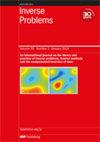确定未知时变边界的反随机抛物线问题的稳定性估计 *
IF 2
2区 数学
Q1 MATHEMATICS, APPLIED
引用次数: 0
摘要
随机抛物方程被广泛用于模拟自然科学中的许多随机现象,如噪声介质中的温度分布、噪声环境中的化学反应动力学或细菌种群密度的演变。在许多情况下,方程可能涉及一个未知的移动边界,它可能代表相变、反应前沿或未知种群。在本文中,我们将重点讨论一个逆问题,其目标是根据在随机抛物方程的特定内部子域中观察到的数据,确定未知的移动边界。本文证明了该问题解的唯一性,并进一步导出了对数型稳定性估计。这使我们能够从理论上跟踪和监测任意内部域中观察到的未知边界的行为。主要工具是随机抛物方程的一种新的卡勒曼估计。作为副产品,我们获得了随机抛物方程的定量唯一延续特性。本文章由计算机程序翻译,如有差异,请以英文原文为准。
Stability estimate for an inverse stochastic parabolic problem of determining unknown time-varying boundary *
Stochastic parabolic equations are widely used to model many random phenomena in natural sciences, such as the temperature distribution in a noisy medium, the dynamics of a chemical reaction in a noisy environment, or the evolution of the density of bacteria population. In many cases, the equation may involve an unknown moving boundary which could represent a change of phase, a reaction front, or an unknown population. In this paper, we focus on an inverse problem with the goal is to determine an unknown moving boundary based on data observed in a specific interior subdomain for the stochastic parabolic equation. The uniqueness of the solution of this problem is proved, and furthermore a stability estimate of log type is derived. This allows us, theoretically, to track and to monitor the behavior of the unknown boundary from observation in an arbitrary interior domain. The primary tool is a new Carleman estimate for stochastic parabolic equations. As a byproduct, we obtain a quantitative unique continuation property for stochastic parabolic equations.
求助全文
通过发布文献求助,成功后即可免费获取论文全文。
去求助
来源期刊

Inverse Problems
数学-物理:数学物理
CiteScore
4.40
自引率
14.30%
发文量
115
审稿时长
2.3 months
期刊介绍:
An interdisciplinary journal combining mathematical and experimental papers on inverse problems with theoretical, numerical and practical approaches to their solution.
As well as applied mathematicians, physical scientists and engineers, the readership includes those working in geophysics, radar, optics, biology, acoustics, communication theory, signal processing and imaging, among others.
The emphasis is on publishing original contributions to methods of solving mathematical, physical and applied problems. To be publishable in this journal, papers must meet the highest standards of scientific quality, contain significant and original new science and should present substantial advancement in the field. Due to the broad scope of the journal, we require that authors provide sufficient introductory material to appeal to the wide readership and that articles which are not explicitly applied include a discussion of possible applications.
 求助内容:
求助内容: 应助结果提醒方式:
应助结果提醒方式:


